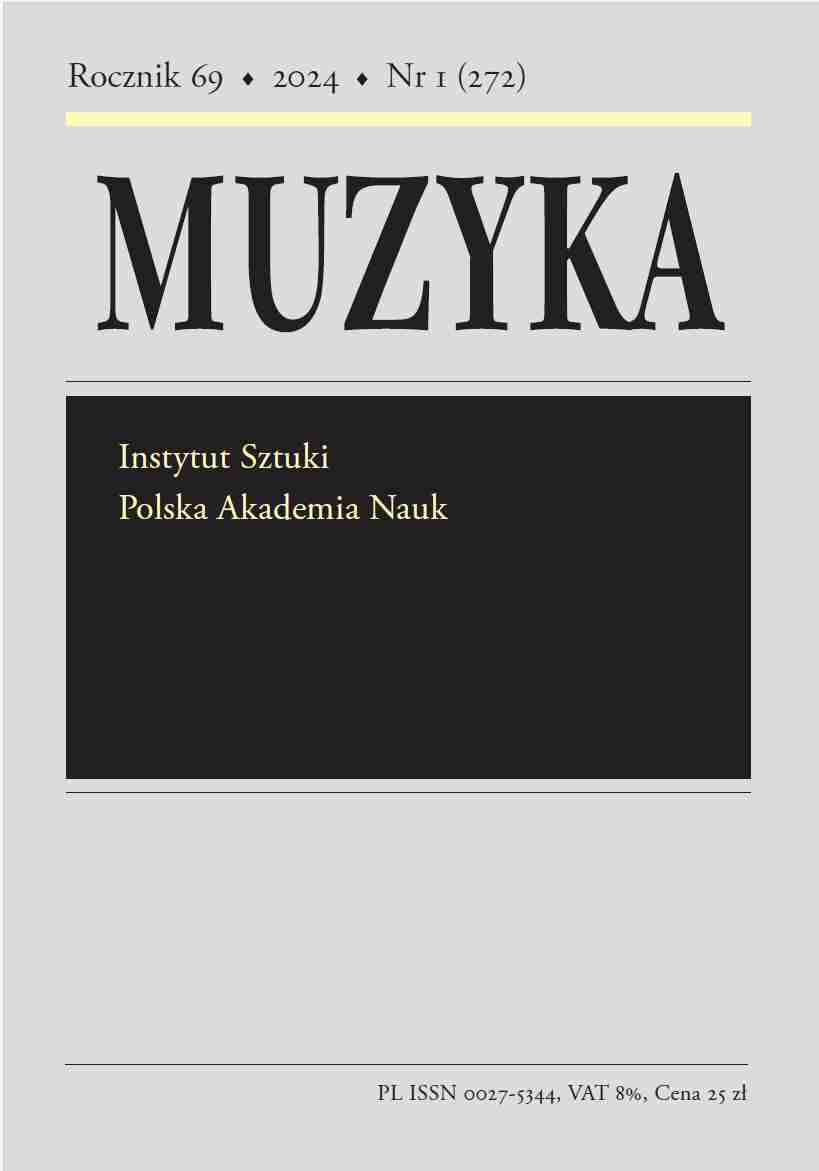Theodor Leschetizky’s 'Concerto Symphonique pour le piano', Op. 9 in the Context of the Composer’s Virtuosic Playing Technique
Abstract
Theodor Leschetizky (1830–1915), born in Łańcut, a pupil of Carl Czerny and Simon Sechter in Vienna, is known today primarily as an eminent piano teacher, but he began his musical career first and foremost as a pianist and composer. He notched up successes as a virtuoso, and his own music won critical acclaim. Like many other nineteenth-century pianists, Leschetizky wrote piano concertos, most likely with himself in mind as the performer of the solo parts.
Analysis of Leschetizky’s early output and artistic activity, as described in press articles from the 1840s, 50s and 60s and in his early biographies (written during his lifetime), proves that he was successful both as a composer and a virtuoso.
This article is devoted to Leschetizky’s one-movement Concerto symphonique pour le piano et l’orchestre in C minor, Op. 9, which he probably never performed, and to the autograph manuscript of this work, now held in the Library of Congress in Washington (US-Wc ML96.L4678 no. 1 Case). I investigate why this piece probably never entered the concert repertoire of its composer or any of his eminent pupils, and was only given its first performance in the twentieth century – in 1977, in the US.
Keywords:
Theodor Leschetizky, autograph manuscript, piano concerto, symphonic concerto, virtuosity, virtuoso, virtuosic cadenza, piano musicReferences
Antonczyk, Wiktoria. „Muzycy polscy w XIX-wiecznym Petersburgu”. Uniwersytet Warszawski, 2019.
Google Scholar
Athanasius-Gross. „Concert des Hrn. Joseph Herzig”. Allgemeine Wiener Musik-Zeitung 3, nr 56 (1843): 235–236.
Google Scholar
Athanasius-Gross. „Concert des Pianisten Theodor Leschetitzky”. Allgemeine Wiener Musik-Zeitung 4, nr 48 (1844): 191.
Google Scholar
Athanasius-Gross. „Local – Revue. Konzert – Salon”. Wiener Allgemeine Musik-Zeitung 5, nr 62 (1845): 247.
Google Scholar
„Aus der Musik-Welt”. Zwischen-Akt 13, nr 254 (1870): [3], http://anno.onb.ac.at/cgi-content/anno?aid=zwa&datum=18701118&seite=3&zoom=33, dostęp 23 VIII 2020.
Google Scholar
Bear, Robert Scott. „Theodor Leschetizky: Selected Works for Solo Piano. A Tape Performance Project”. Dysertacja doktorska, University of Maryland, 1996.
Google Scholar
Blanchard, Henri. „Revue Critique. Musique de Piano”. Revue et Gazette Musicale de Paris 34,nr 21 (1854): 272–273.
Google Scholar
Bree Malwine. The Groundwork of the Leschetizky Method, przekł. Theodore Baker. New York: G. Schirmer, 1902.
Google Scholar
„Buntes Bouquet”. Die Gegenwart. Politisch-literarisches Tagsbatt 3, nr 210 (1847): 924.
Google Scholar
Chmara-Żaczkiewicz, Barbara. „Teodor Leszetycki. Notatki z biografii artysty i pedagoga w świetle stosunkow z rodziną, przyjaciołmi i uczniami (część I)”. Muzyka 63, nr 4 (2018): 88–112.
Google Scholar
Chmara-Żaczkiewicz, Barbara. „Teodor Leszetycki. Notatki z biografii artysty i pedagoga w świetle stosunkow z rodziną, przyjaciołmi i uczniami (część II)”. Muzyka 64, nr 1 (2019): 22–68.
DOI: https://doi.org/10.36744/m.347
Google Scholar
„Feuilleton. Concerte”. Neue Freie Presse 7, nr 2231 (1870): 1–2, http://anno.onb.ac.at/cgicontent/anno?aid=nfp&datum=18701112&zoom=33, dostęp 23 VIII 2020.
Google Scholar
Gronke, Kadja. „Napravnik, Ėduard Francevič”. W: MGG Online, red. Laurenz Lutteken https://www.mgg-online.com/mgg/stable/58163, dostęp 20 V 2020.
Google Scholar
Hofmeister, Friedrich. Monatsberichte, [grudzień] 1875, s. 296, https://hofmeister.rhul.ac.uk/2008/content/monatshefte/1875_12/296.html, dostęp: 23 VIII 2020.
Google Scholar
Hughes, Edwin. „Leschetizky on Piano Playing”. The Etude, https://etudemagazine.com/etude/1909/05/leschetizky-on-piano-playing.html, dostęp 23 VIII 2020.
Google Scholar
Hullah, Annette. Theodor Leschetizky. London: John Lane, The Bodley Head, 1906.
DOI: https://doi.org/10.2307/904506
Google Scholar
Kube, Michael. „Schulhoff, Julius”. W: MGG Online, red. Laurenz Lutteken https://www.mgg-online.com/mgg/stable/47833, dostęp 15 V 2020.
Google Scholar
„Kunstnotizen”. Blätter für Theater, Musik u. Kunst 16, nr 255 (1870): 340–341, http://anno.onb.ac.at/cgi-content/anno?aid=mtk&datum=18701118&seite=1&zoom=33, dostęp 23 VIII 2020.
Google Scholar
Mahler. „Konzerte”. Der Sammler 4, nr 64 (1844): 259.
Google Scholar
Newcomb, Ethel. Leschetizky as I Knew Him. New York: D. Appleton and Company, 1921.
Google Scholar
Nottelman, Karsten. W.A. Mozart Sohn. Der Musikerund das Erbe des Vaters. Kassel, New York: Barenreiter, 2009.
Google Scholar
P.B. „Correspondenzen. Ischl, den 28 August 1845”. Wiener Allgemeine Musik-Zeitung 5, nr 106 (1845): 423.
Google Scholar
Philokates. „Drittes Concert Spirituel”. Wiener Allgemeine Musik-Zeitung 5, nr 23 (1845): 90–91.
Google Scholar
Philokates. „Konzerte. Konzert des jungen Pianisten Theodor Leschetizky”. Wiener Allgemeine Musik-Zeitung 5, nr 19 (1845): 75.
Google Scholar
Potocka, Angele. Theodore Leschetizky. An Intimate Study of the Man and the Musician, przekł. Genevieve Seymour Lincoln. New York: The Century Co., 1903.
Google Scholar
„Recensionen”. Deutsche Musik-Zeitung 11, nr 30 (1861): 235–236.
Google Scholar
Rottermund, Krzysztof. „Michał Bergson – szkic do portretu”. Muzyka 59, nr 2 (2014): 61–78.
Google Scholar
Schuster, Herman M. „Die erste Falte”. Allgemeine Kunst-Chronik 7, nr 2 (1883): 17–19, http://anno.onb.ac.at/cgi-content/anno?aid=okc&datum=18830113&zoom=33, dostęp 23 VIII 2020.
Google Scholar
Siegel, Judith S. „Mission from Ischl”. The American Music Teacher 23, nr 3 (1974): 29–30.
Google Scholar
Smith, Fanny Moris. „Theodor Leschetizky”. The Etude 12, nr 21 (1903): 475.
Google Scholar
„Tagesgeschichte. Musikbriefe”. Musikalisches Wochenblatt 12, nr 8 (1881): 90–91.
Google Scholar
Witmann. „Local – Revue”. Allgemeine Wiener Musik-Zeitung 3, nr 102 (1843): 427.
Google Scholar
Statistics
Abstract views: 490PDF downloads: 374
License
Copyright (c) 2020 Ewa Bogula

This work is licensed under a Creative Commons Attribution-NonCommercial-NoDerivatives 4.0 International License.
The author grants the publisher a royalty-free nonexclusive licence (CC BY 4.0) to use the article in Muzyka, retains full copyright, and agrees to identify the work as first having been published in "Muzyka" should it be published or used again (download licence agreement). By submitting an article the author agrees to make it available under CC BY 4.0 license.
Articles from 2018/1 to 2022/3 were published under a Creative Commons license CC BY-NC-ND 4.0. During this period the authors granted the publisher a royalty-free nonexclusive license (CC BY-ND 4.0) to use their article in "Muzyka", retained full copyright, and agreed to identify the work as first having been published in our journal should it be published or used again.










